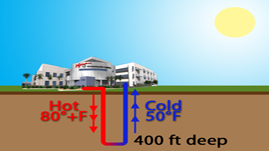Teachers' Domain - Digital Media for the Classroom and Professional Development
User: Preview

Source: “Building Vegas GREENer”
In this video segment from Vegas PBS, visit a construction site where a geothermal heat pump system is being installed to provide a new building with an energy-efficient way to meet its heating and cooling needs. Geothermal energy systems like this one circulate water through two pipes—one a supply line to the building and the other a return line from the building. Depending on the season, the water delivers heat to the building to warm it or removes heat from the building to cool it. Geothermal systems replace traditional heating and air conditioning systems that require considerably more fossil fuel to run.
Just a few feet beneath the surface almost anywhere on Earth, the temperature is more or less constant year-round. In most places, it's usually between 50° and 60° Fahrenheit (10–15° Celsius). Building architects and engineers have designed heating and cooling systems based on the understanding that the subsurface is generally warmer than the air above it in winter and cooler in summer. These heating and cooling systems are called "geothermal" systems. Geothermal systems represent an environmentally preferable way of controlling indoor climates because they don't rely solely on burning fossil fuels. Instead, they are designed to concentrate heat that is already present in the soil or groundwater.
The heart of a geothermal system is a heat pump, a device that moves existing heat from one place to another using liquid that circulates through a series of pipes. This can mean either taking heat from the ground and moving it into a building, or taking heat from inside a building and moving it underground. In this way, the subsurface acts as a heat source in winter and a heat sink, or receptacle, in summer.
A geothermal heat pump system can be configured in two basic ways. A closed-loop system, like the one described in the video, uses water—or a mix of water and antifreeze—that it keeps in continuous use. The fluid circulates through a series of pipes configured in a vertically or horizontally oriented loop. In winter, it absorbs heat from the ground as it moves. When it enters the building, the water passes through a heat exchanger inside the building. This device uses electricity to extract the absorbed heat from the pipes. It concentrates this energy and releases it inside the building via a duct system, which distributes the heat to different rooms. In summer, the process is reversed. The pipes take excess heat from inside the building and carry it underground, where it can be absorbed by the soil or water. The facility featured in the video also uses conventional air conditioning (AC) for cooling. Still, because the water running through the underground pipes is used to cool 100°F air from the outside to perhaps 80°F before it enters the AC system, the AC system is much more energy-efficient.
An open-loop system uses groundwater from a lake, well, or aquifer as the heat source and heat sink. (As with soil, the temperature of underground water is more or less constant year-round.) The groundwater enters the heat pump system through intake pipes, is circulated through submerged pipes or coils, and, after running through the heat exchanger, is expelled into a separate drainage or collection area.
Ground-source heat pumps deliver about three to four times the energy they consume. All totaled, a geothermal system can reduce heating costs by 30 to 70 percent and cooling costs by 20 to 50 percent. They may cost several thousand dollars more to install, but the payback through savings can come in just a few years.
To learn more about energy use and renewable energy sources, check out Snapshot of US Energy Use, Energy Sources, and Global Warming: Beyond Fossil Fuels.
To learn about another cleaner way of generating energy for use in a home or building, check out Solar Power.
To learn how Earth's internal heat fuels some incredible natural formations, check out A Visit to Yellowstone.
 Loading Standards
Loading Standards